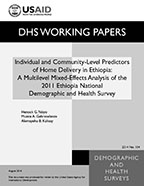
Abstract:
Introduction: In Ethiopia, despite existent
intensive efforts to improve maternal health,
the proportion of births delivered at home
remains high and is still the top priority
among the national health threats. The study
aimed to examine effects of individual and
community-level factors in women’s decision
to deliver at home versus in a health
facility.
Methods: Data for this study were obtained
from the nationally representative 2011
Ethiopia Demographic and Health Survey (EDHS
2011) and focused on a sample from 576
communities of 7,908 women whose most recent
births were within five years preceding the
survey. The data were analyzed using a two
level-mixed-effects logistic regression model
to determine the individual and community-
level factors associated with place of
delivery.
Results: In Ethiopia, 88% of deliveries took
place at home. Both individual and community-
level factors were associated with women’s
choice
for place of delivery. Lower educational
levels of mothers (OR=2.74; 95% CI: 1.84,
4.70) and their husbands (OR=2.31; 95% CI:
1.68, 3.18) were both positively associated
with the odds of giving birth at home. The
net odds of home delivery among mothers
without antenatal care (ANC) visits for their
recent pregnancy was 3.7 times higher than
among mothers who made the recommended four
or more ANC visits (OR=3.72; 95% CI: 2.85,
4.83). Non-exposure to radio or television
messages (OR=1.51; 95% CI: 1.13, 2.01),
parity of six or more births, (OR=2.68, 95%
CI: 1.96, 3.68) and
perceived problems reaching health facilities
due to distance (OR=1.29, 95% CI: 1.03, 1.62)
were positively associated with home birth.
With regard to the community-level
characteristics, rural communities (OR=4.67,
95% CI: 3.06, 7.11), pastoralist communities
(OR=4.53, 95% CI:
2.81, 7.28), communities with higher poverty
levels (OR=1.49; 95% CI: 1.08, 2.22), and
those with lower ANC utilization (OR=2.01,
95% CI:
1.42, 2.85) and women in areas with perceived
problem of distance to health facilities
(OR=1.29; 95% CI: 1.03, 1.62) had a positive
influence
on women to give birth at home.
Conclusion: Not only individual
characteristics of the women but also
community-level factors determine women’s
decision to deliver at home. Thus efforts to
decrease the proportion of births delivered
at home in Ethiopia should focus both on
individuals and on communities.
 Individual and Community-Level Predictors of Home Delivery in Ethiopia: A Multilevel Mixed-Effects Analysis of the 2011 Ethiopia National Demographic and Health Survey (PDF, 640K)
Individual and Community-Level Predictors of Home Delivery in Ethiopia: A Multilevel Mixed-Effects Analysis of the 2011 Ethiopia National Demographic and Health Survey (PDF, 640K)
